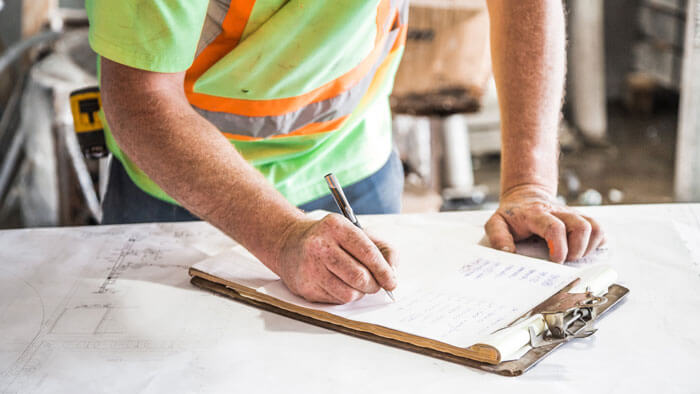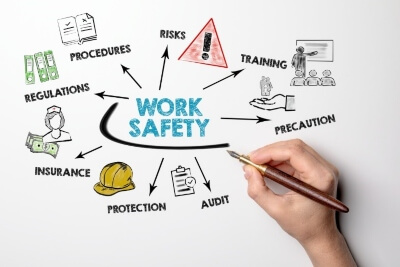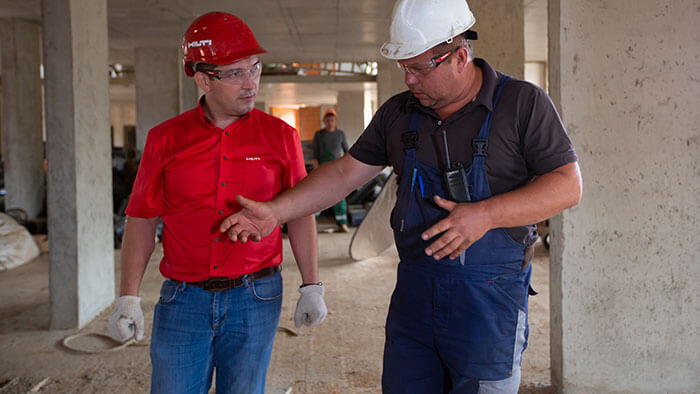What to Look for in a Construction Job Site Safety Inspection
Oct 23, 2019 JHSC, Workplace InspectionsEveryone working in construction knows that time equals money, and there is never enough of either. The pressures associated with getting the job done on time AND budget are well entrenched in the industry.
What any veteran of the construction industry also knows is that health and safety is essential. We all want to go home with all the same parts we came to work with. However, how does that balance with the fact that to make money, we have to hustle.
I would love to say I gold-plated every job I have ever done, followed all the rules, looked out for my safety, but to be perfectly honest – to save time, I didn’t.
In any sector, we have to balance productivity, quality, and worker safety. The older I am, the more safety conscious I have become. Not all workers think the same, however. It falls to the supervisor of the site to watch out for the safety of their crew. To maintain efficiency, taking a proactive approach saves headache, aggravation, time and money. Being proactive on the job site means doing inspections.

Now, if you are new to the position of supervisor, you might be asking, what is a construction site safety inspection? Simple, it is taking the time to identify and document potential and existing hazards on your job site. After they have been identified – they can be controlled so that they DO NOT lead to one of your workers getting hurt.
The next question you are probably asking is, how do you conduct a safety inspection? That is a bit more complex.
Construction differs from the industrial sector in that it is a continually changing environment. As the work progresses some hazards disappear, while others emerge that did not exist before. The site changes not only weekly, but arguably daily – if not hourly. So how often should a construction work site be inspected? That depends. Formal inspections must be performed at least every week and documented. Daily inspections with associated morning toolbox talks are used to support the changes in between our weekly formal inspections. Factors such as the trade, progress, weather, etc. will dictate the hazard potentials that will be covered on inspection.
The basics requirements for an effective job site safety inspection would cover the following:
- Conducting documented inspections at least weekly
- Making all inspections (documented and visual) a routine part of every day
- Informing workers of any conditions or hazards, they are aware of and ensuring controls for these hazards are put in place to protect workers
- Take corrective actions on hazards or conditions identified throughout any inspection and, where they are unable to address specific hazards, bring them to the Employer’s attention
- Engage workers in discussing health and safety issues that may arise during their inspection
- Documenting their inspections. This is a critical step.
FREE RESOURCE:
Construction Regulation 213 can be used as a guide as to what should be included in a job site safety inspection. There is a reason that these rules have been put in place. What you will inspect depends on the nature of the work taking place and the trades that may be on site to perform that work, but the following is an excellent list to ensure you do not miss anything.
-
- Personal Protective Equipment – We all know that the worker is responsible for wearing their PPE. Hardhat, boots, high-vis, harness, etc. We also know that for some unknown reason, workers do not always wear their PPE. As a supervisor, you have to check for this.
- Noise – Construction by its very nature is not quiet. Workers need to be protected. Now, if a worker is being exposed to over 85db continuously over their entire shift, then we may have to look into controls other than simple earplugs.
- Hygiene – What are our facilities like, such as access to drinking water, and *ahem* when nature calls. The regulations are very specific about this, and not always considered – or maintained once the project gets underway.
- Housekeeping – Construction is messy; you’re either building something or tearing it down. Debris can be a tripping hazard, or it can fall on us. Some of the products used are not exactly good for us, so the supervisor is responsible to ensure that it is disposed of correctly.
- Fire Safety – Site depending, there can be flammable chemicals present, exposed electrical, grinding, welding, or even heaters. Not to mention those random cigarette butts that get tossed wherever. Workers need to be aware of and follow your fire safety plan.
- Traffic control – on-site and off – Now offsite is governed by “Book 7” if you are closing live lanes of traffic, you have to ensure this is being followed at all times. A crew member standing in the middle of the road to allow a truck to back up isn’t okay. Onsite traffic control considers the equipment and vehicles constantly moving around. Spotters are required, but not always used.
- Access and Egress from work areas – Stairways, runways, ramps, and ladders are common on job sites. How well were they built, and how appropriately are they being used is something to watch out for. Carrying material up a ladder and maintaining 3 points of contact is happening.
- General Equipment – Sites have a lot of different types of equipment depending on the job. The Regulations spell out the controls for anything over 10hp. Things to inspect are the condition, maintenance, training of the worker.
- EWP – Elevated work platforms are fantastic. They offer a safe way for a worker to be aloft. As a supervisor you have to ensure they are correctly inspected, workers are tying off, and the unit is not being overloaded, or a ladder is not being put on the skyjack that was just a little too short for the task.
- Cranes and rigging – As work is being done, materials are always moving. Cranes save a lot of time. Have the cranes been inspected, are the operators trained, capacity matched to products, angles and distance all have to be inspected. As for inspecting the rigging, I have been told that “a pretty rigging job, is a safe rigging job”. Regardless, all rigging equipment should be inspected as well.
- Overhead power – Ground level hazards are easily seen, but do not forget to look up. Overhead power sources pose a huge risk to workers. Approach distances vary depending on voltage, be aware of what is on or near your site. Just as recently as Sept 19, 2019 – 2 workers were killed in a 24 hour period, according to the Electrical Safety Authority.
- Excavations – Pose not only a fall hazard but can collapse on a worker or can fill with water. If heavy equipment is present on-site or materials are placed closer than 2 meters from the edge, we have a tipping hazard to control. Not to mention, we do not want to see a crew member alone in a trench without someone close by (O.Reg 213 s.230).
- Confined Space – If workers are entering confined spaces, then there is an entire regulation dedicated to the requirements surrounding the measures, procedures, and protective devices that must be in place (O.Reg 632/05). If workers are not authorized to be in those environments, have they been made aware of the hazards associated with them?
Construction site inspections are more complex than the standard industrial workplace inspection, and it can be very lengthy to explain everything that may need to be inspected as all construction sites differ. The dynamic element of a job site keeps a supervisor on their toes. Being aware of what to inspect and control is the first step of ensuring your job site and workers remain safe, but before you can do this, you must be familiar with your site, the work taking place and the hazards associated with that work. After considering the information above, create an inventory of the hazards present on your site. This can act as a framework to begin an effective inspection. What you learn about hazards on one site, can then be carried forward to the next project.
Supervisors play perhaps the largest and most significant role in keeping workers in the workplace safe; and in line with a Supervisors requirement to demonstrate due diligence, it is something that must invested in.
Geoff Rowatt | CHRP | Safety Trainer






